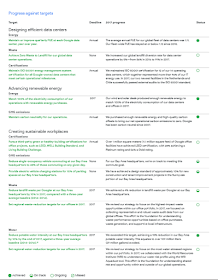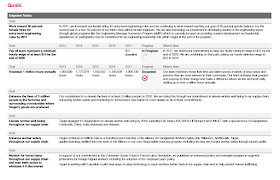Sustainability reporting used to be about activities and actions whereas today it is more about impacts and intentions. Substantiated intentions, that is, by which I mean T-A-R-G-E-T-S. Yes, that awful, threatening, potentially blood-pressure-raising concept of actually making a public commitment to making a difference. One of the things I find most frustrating about many sustainability reports is the extreme lengths companies go to in order to describe their mission, vision, what's important to them, what's important to stakeholders, what's important to the world and why it's ALL so important ("Sustainability is in our DNA" and "The world is about to end") .... but when it comes to saying what they plan to do about it: radio silence. Vague intentions, aspirations, declaratory blurb - it's all very nice but, well, no teeth.
Andrew Wilson, expert advisor on sustainability, author of Green to Gold and The Big Pivot, has done leading-edge work in this area. He's even quite positive in his views of how targets have progressed and become embedded in the way most large companies report on sustainability. You can gain some comfort from his article from December 2017 here. He concludes that 94% of the largest 200 companies in the world include targets in their Sustainability Reports.
You can check out Andrew's Pivot Goals database, containing 3,923 goals that have been publicly disclosed by (large) companies in their sustainability communications over the past few years (the database contains some duplication with both original goals and those that have been superseded or replaced). While this is apparent progress, it's by no means close to critical mass for all the thousands of companies that report on sustainability. Also, as you might expect, the distribution of targets is uneven - in the Pivot Goal database, for example, in the pharma sector, I counted 13 companies with targets, ranging from one company that has 62 targets and one that discloses just one target.
Other aspects of target setting are coverage and quality. Coverage is the extent to which a company discloses targets for all material sustainability aspects versus targets that are limited to one area, say, environmental impacts which is the most popular. Quality is the extent to which targets are SMART. You know what SMART means. SMART is not: "Continue to improve our environmental impacts". Just sayin.
Many of the reports I view and review are GRI-based and claim to be in accordance with GRI Standards at core or comprehensive level. Now, GRI has made reporting of goals and targets mandatory in the Management Approach Disclosures. Disclosure 103-2 requires (the organization SHALL report) disclosure of goals and targets. Well, sort of. The mandatory part is diluted by the addition of some small print: if the management approach includes that component.
Additional guidance suggests including context, time-frame, reference to legislation if relevant and more.
So, according to GRI, for GRI compliance, reporting of targets is mandatory if you have them. If you don't, no problem. Well, no problem is exactly how most reporters approach the Approach. It's so easy to say "we are committed to", "we place great importance upon", "we are passionate about" and all those other gloriously positive affirmations, but when it comes to the crunch, it's apparently more convenient to ignore the bits that bolt those commitments down in the organization and give stakeholders something to believe in. I believe disclosing targets should be a mandatory element of material topic reporting. Every single GRI Topic-specific Standard should include a requirement to disclose SMART targets - not IF they exist, but BECAUSE they should exist. And if they do not exist, conformance to GRI Standards should not either.
Some (random) examples of how companies commit in sustainability reports:
Arguably the best-of-the-best expression of public commitments and consistent reporting of progress is Marks and Spencer, whose Plan A, when it was created in 2007, immediately set M&S apart from the crowd with a bag of 100 commitments representing the most far-reaching and comprehensive set of targets by any company at that time (as far as I know). Although Plan A's tagline was "Because there is no Plan B", Plan A has continued to reinvent itself and currently goes under the name of Plan A 2025. Behind the scenes of Plan A is a strong commitment to sustainable business, and business that positively impacts people and planet, and the pace has been maintained even at times when the company's financial results have been a bit wobbly. Marks and Spencer's 2018 Plan A Report includes a detailed account of progress against all targets across the four Plan A pillars in a way reflects the M&S brand: quality, detail and tailored to meet a range of needs.
Walmart's 2018 Sustainability Report includes a range of specific commitments at the start of its 230-page report. The targets are SMART enough and cover all areas of sustainability priorities - a comprehensive approach.
At the end of the report, Walmart discloses how it is doing against these commitments:
While it's possible to correlate progress reported to the commitments made upfront, it takes a little detective work to sort it all out as the language used is different in both cases. However, Walmart's (mostly) specific time-bound targets and progress statements are enough to quench my thirst for target-juice in this report.
CVS Health also does a great job in its 2017 Corporate Social Responsibility Report with multi-year targets and reporting of progress in the reporting year. Across four pages, CVS demonstrates a mature view of its role in society with targets that reflect its impacts on society (help create a tobacco-free generation by acting to reduce youth smoking) as well as targeting improvements it its own operations. The targets are also in line with the material impacts CVS Health defines in its report.
A super presentation of targets is from Sinyi Realty Group, one of Taiwan's leading real estate agencies in its 2017 Corporate Sustainability Report. For key strategic areas, the company sets long-range goals, medium term targets to 2025 and short-term targets for the coming year. Sinyi transparently reflects performance against the short-term targets set in the reporting year. No room for misinterpretation or detective work required here: it all hangs together very credibly.
Google's 2018 Environment Report includes a set of targets and progress made against these. It's a clear enough presentation and scoreboard markers give you a quick overview of progress. However, while this is totally fantastic, the targets are a mixed bag, for example, two of the targets are: set targets and others are either not time-bound or relevant for the single reported year - which in sustainability terms is no time at all. All targets relate to the direct environmental impacts of Google's own operations, for example, achieving zero net operational carbon emissions, which Google has impressively done for at least the past five years.
Of course, I couldn't write a post about targets without looking at Target Corporation. I mean, if your name is Target, you have to have targets, right? Well, Target doesn't disappoint, though, oddly enough, Target's targets are called goals 😂😂😂 But, whatever they are called, they are extensive and are presented across 7 pages in Target's 2018 Corporate Responsibility Report, followed by a couple of pages of upcoming goals (or targets) in areas not measured to date or not the subject of goals so far.
There is no doubt in my mind that the inclusion of public commitments is both a way to reinforce trust with stakeholders and a tool to catalyze performance improvements. Several leading companies are doing this really well, and I tend to agree with the analysis above that more are doing so these days than in the past. However, the leading companies across the world represent only a small fraction of the entire population of reporting companies, and many (I might even say, most) of them do not even hint at targets or commitments.
So, let's be clear: If you want stakeholders to believe you are serious about sustainability, or whatever you call it in your organization, make SMART public commitments in key areas of impact and report your progress against these year on year.
Of course, a great addition to any Sustainability Report would be the inclusion of a target to provide a lifetime supply of free ice cream to anyone who blogs about your targets on the CSR Reporting Blog.
Happy Holiday Season and Happy 2019 to all CSR Reporting Blog readers!










